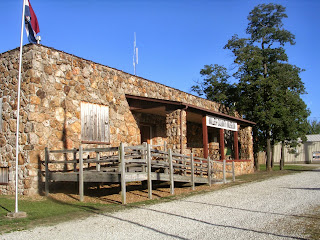
Freeman Homestead 1947 (Frank Hohenberger photo)
One of the types of jobs we do at the Brown County Historical Society Archives is to help homeowners do research on their old houses or land. It’s not typically genealogical research, but you apply the same principles and methods. The only difference being is that you have different types of documentation to look for to determine the age of the aged structure or names of the first land owners. Most of my helpers are acquainted with where to start, but one of my hens (as we like to call each other) has very good skills in land/house research.
We were approached recently by a couple that had fallen in love with an old homestead that used to be part of the Freeman Orchard. They had visited us earlier this summer and tried to buy the house, but were outbid in the Estate sale. Fortunately for them the bidder turned around later and put it up for sale again. This time they lucked out and got their dream home. If you want to do research on your old home and don’t know where to begin then one of the best places to try first is your local historical society. If they don’t have info on your individual house then at least they can show you how to get started. I was able to give this couple one of our county’s “Interim Report” that was published by the Historic Landmarks Foundation. These should be available in most counties in Indiana. It is a detailed list of all the old homesteads and other historic structures with a brief description and an age of the structure. This book is a good starting point to see if your home is on this list.
There are a lot of sources out there that anyone can start with to do their own research. The first and easiest is to do whatever research you can on the internet. You can follow some of the examples that my lead researcher found. First there were a couple of mentions in two different stories, then a digital image of the house was found, and finally she mentions an on-line County database that anyone can access.
Reference Links:
1. A Google books search found a “1908 State Geologist Report” that mentions two orchards in Brown County, one being Freeman Orchard in its heyday.
2. An article in an on-line version of “Our Brown County” mentions Freeman Orchard.
3. The Lilly library in Bloomington, Indiana has on-line digital images of Frank Hohenberger’s photos from the early part of the 1900s, one of those was the old homestead on Freeman Orchard in 1947.
There is a database that is accessible on-line from our county government where you can access Property Cards of the land and homes in Brown County. I’m sure a lot of counties probably have these on-line now to be accessible by the public. This is the gist of the report my volunteer found. “The property record card states that the current dwelling was built in 1948, it is my opinion that the original structure was largely gutted and rebuilt at that time, leaving very little of the original structure, thus giving the effective construction date of the dwelling a 1948 date. The dwelling was reconstructed to maintain the same appearance. Need to do some research at the County office building regarding the construction.” As you can see there are more records that can be accessed on-site at the county level. I e-mailed our couple and gave them some more places they could look into. I also told them to examine their house to see if any of the original house structural items seem to be part of the original wood structure. Here are a few of other items that can be looked into for further research at the County level.
Abstract of Title
Property Card
Deed Records
Building Permit Records
Tax Duplicate Books

View from Freeman Ridge towards Bean Blossom (Frank Hohenberger photo)































